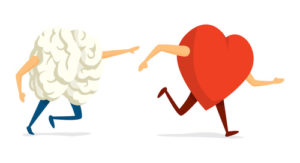by Michael Ellison
At its most simple, conflict and persuasion are largely handled by two different, and unequal, partners in the human brain.
Persuasion is most often the result of a logical presentation of information that appeals to the cerebral cortex, or thinking portion of the brain. Through their long training in law school and years of experience in court, lawyers are taught that emotional appeals have little weight on the fine grind of the wheels of justice—logic and precedence prevail.
 Conflict, however, is not cerebral, it’s emotional. Conflict is regulated by the ancient mammalian brain, or limbic system, which is largely concerned with threat assessment and survival strategies. Not surprisingly, survival trumps intellect.
Conflict, however, is not cerebral, it’s emotional. Conflict is regulated by the ancient mammalian brain, or limbic system, which is largely concerned with threat assessment and survival strategies. Not surprisingly, survival trumps intellect.
In fact, when the limbic system gets involved, emotions run high and it shuts off the input from the wiser cerebral cortex. The limbic system rules our behaviors from its fang-and-claw mandate. This is the biological origin of the fight or flight response—our reasonable, logical, experienced cerebral cortex is held in abeyance until we are calmed sufficiently to enable us to think. This has more to do with the success or failure of mutually satisfactory outcomes in ADR disagreements than might be first evident.
The Emotional Brain and ADR
Professionals embroiled in ADR processes marked by interpersonal contention would do well to remember to speak to the ‘emotional brain,’ the limbic system, with behaviors and language that bespeak of calm and safety, foregoing the appeals to logic for the moment. Only after the limbic system’s alarms no longer sound will the logical cortex be available to participate.
For example, seeing clients in obvious emotional turmoil should prompt a strategic change in communication: Instead of a fact-based discussion appealing to logic (perhaps the strength of the attorney or other professional), spend a few minutes in empathy with them. Looking down at the fact sheet shows discomfort; instead, look steadily into eyes perhaps filled with anger, or tears, and voices raised with frustration, fear, or hostility, and calm yourself first. There is already plenty of adversity in the room; by initially striving to steady our own nerves, we communicate tolerance of the clients’ overarching emotional excesses and simultaneously our desire, our need, for them to achieve some measure of emotional equilibrium.
Avoid the phrase, “I understand how you feel”—for we can’t really know exactly how they feel, and it demeans their experience. Often, legal experts don’t acknowledge the sense of loss felt by those in ADRs; for with loss comes grief. Knowing what to say in times of grief isn’t taught in law school—and so we frequently say words that aren’t helpful, or are insulting in their naïveté.
Attentive listening to distress, saying little, but remaining present for clients is, for some, an arduous task—one that prompts an uneasy move to discuss the fact sheet all too often. Having the courage to sit in another’s discomfort, rage, or verbal harangue—at least for a few minutes—is a strategy which may allow the emotional wave to pass, so that logic and persuasion can follow.
It is surprising how a phase like, “this must be very hard on you and your family,” said in a calm voice with meaningful eye contact, can restore emotional balance in another—signaling a readiness to then move to considerations conducive to logical and compromise.
Unspoken Agendas Need Sympathy
Understand that clients have a deeply felt, but unspoken agenda: illustrating how emotionally they have been wronged or damaged. You, their legal counsel or ADR specialist, will see and feel it too, to be on “their side.” Perhaps the legal process or dispute will be resolved in a way suitable to their expectations. Savvy experts in ADR know being empathetic to the client(s) and gently introducing language that seeks a solution will be the most persuasive.
In an adversarial legal culture, looking for mutual compromise and solutions each party can bend toward, if not fully embrace, is required for a successful ADR experience. The professional who can steer clients away from emotional quicksand with empathy, and can provide reassurance, may find a middle ground for a quicker agreement with the other party. Remember that wise sage, The Little Prince, who reminds us: “It’s only with the heart that one sees rightly.”
Having said that, it does not mean a therapy session is called for—just a softer, more sympathetic, discussion of possible solutions. There is a lesson from solution-oriented therapists, however, well worth mentioning: The client is the expert on the problem, but is also (often unknowingly) the expert on the solution as well.
While this may seem contradictory, experience bears it out. That is, the wise ADR specialist knows the mammalian brain of the complainant is in fight mode, not in the right mind set for a solution-focused discussion. Therefore, a few moments of genuine, heart-felt discussion is in order before any attempt at reconciliation. For example, “Surely this is a very difficult situation for you; what comes to mind that you can do today to make this better?” is the type of opening question that both expresses empathy and follows it with an attempt at a client-centered solution.
Especially in high-conflict litigation, the emotional flood of one or both contestants occasionally prevents a rational discussion of solutions until further into the allotted time for the case. Don’t forego empathy and a client-founded solution in the midst of clients who raise their voice and remain angry; instead, work to calm the reptile brain until logic ‘intrudes’ into the discussion. How is this done?
Turning the Emotional Balance to Safety and Security
Louis Cozolino, counselor and Professor at California’s Pepperdine University and author of The Neuroscience of Human Relationships, discusses the concept of “sociostasis” to explain how best to understand the neurobiology of conflict.
Like homeostasis, that old high school science concept that explains the balance of chemicals in our bodies necessary for life, sociostasis is the balance between persons necessary for feelings of interpersonal safety and security in relationships. If anyone’s reptile brain is evident in their verbalizations or demeanor, this must be soothed before any meaningful efforts at remediation can be successfully attempted.
Take child care as an example. High-conflict families often argue about the proper care of children. When the care provided by the “other” is seen as negligent or abusive, the protective portion of the brain wants to control the situation around the child to insure no damage can occur. Often, however, the rights of the other parent must be factored into the ADR resolution. While not always easy to do, addressing the safety needs of the children early in the ADR discussion may open the door for further compromise and eventual ADR case closure. The sociostasis theory, applied to the ADR process, means the ADR specialist is part of the family, or families, in dispute, and each side –whether it is recognized overtly or not – will want the ADR specialist on “their side.”
 I recently was involved in a child custody dispute between parents who had divorced and then each had married another person. In the ADR meeting, these four angry adults met and began arguing over the merits of who was the better parent, who was the worst step-parent, and where the kids would be best served, among other issues. These are all typical of the usual ADR situation.
I recently was involved in a child custody dispute between parents who had divorced and then each had married another person. In the ADR meeting, these four angry adults met and began arguing over the merits of who was the better parent, who was the worst step-parent, and where the kids would be best served, among other issues. These are all typical of the usual ADR situation.
I wanted to diffuse the hostility, focus on the children, and open them to compromise. First, I asked each biological parent to draw on separate pages of blank paper a portrait of each of the three children. It’s no secret that parents view their children differently; when each parent saw the other parent’s drawing, there began a softening to the rancor in the room—both parties laughing at the poor execution of the artwork and sharing how each child showed each parent (and step-parent) a different side of themselves.
I then placed all six drawings on the table and asked if all remarks made by all parties could be made while looking at and thinking about these young persons. This placed the (unseen) children into the sociostasis of the two parents, the two step-parents, and me. The issues of safety for the children were arduous. The role of alcohol abuse in one family was particularly challenging. Eventually, a safety plan was reached which assured each parent, as much as was possible, to focus on child welfare and forego attacks on the other biological parent.
Similarly, the process went through a second iteration with the step-parents, each aligned with their respective spouse, who are also trying to form some sort of attachment with their step-children, and in this case—to fight the other step-parent! By re-focusing the step-parents on the children’s behalf, represented by the drawings which I continued to pass around when the discussions got heated, they could release their antagonism for the other couple and make meaningful contributions. Notably, one step-parent voiced to her partner the “conscience” of child-care and how best to serve the children. This bio-parent was able to hear the logical message of compromise and child-centeredness only after the emotional soothing proffered by the partner.
Seen, Safe, Soothed, and Secure: Requirements for ADR Progress
The psychiatrist Daniel Siegel, MD., author of numerous articles and books in the burgeoning field termed Interpersonal Neurobiology, writes extensively on the role of attachment in human relationships. It may seem to be a topic outside the realm of ADR, but I would argue attachment is of crucial concern in the failed relationships we see in the ADR process. Our interpersonal attunement to the disputants in ADR is therefore indispensable to successful compromise.
Put simply, Siegel argues that attunement to another can be summarized by the “Four S’s”
- Seen: Do others acknowledge our emotional presence, or are we (or they) emotionally unavailable, or invisible, to others?
- Safe: If we are not safe, we are in flight/flight or freeze mode—unable to focus on more than survival instincts.
- Soothed: In relationship, can we be soothed by the presence of another, or are we wailing in discord? Can we soothe ourselves, or another?
- Secure: Our attachment is unconditional—we don’t have to be perfect, or perform just right—to be secure in relationship. We can make errors and not be thrown away like trash. Security, like the old saw says, means others known us, but love us anyway.
So—how does this work?
These four concepts, like a pilot’s checklist of essential tasks, can serve to remind us of the interpersonal skills conducive to relationship success when we perform ADR roles. To be Seen is to show our concern for the emotional lives of the disputants and reveal to them our concerns for their view.
To ensure Safety, remind everyone that yelling, expressing derogatory remarks to others, and other forms of control/intimidation cannot be tolerated. If such outbursts occur, a mandatory 15-minute break may enable a calmer tone going forward. If a proceeding is perceived as unsafe by any party, the ADR process is put on hold until peace is restored.
Soothing is one of the most frequently seen strategies of attachment in ADR sessions. Many ADR specialists possess the even-tempered discussion habits inculcated by legal training or experience in ADR settings, which serve to soothe parties upset by disagreement. Remember, significant numbers of persons involved in ADR experiences may be victims of trauma and therefore:
- easily triggered to anger,
- yelling to control the behavior of others, or
- other manipulations of the milieu
so they can feel seen and safe. When presented with these behaviors, re-set the ADR conditions immediately by performing soothing behaviors.
On rare occasions, an ADR specialist may try to out-yell disputants to try to re-establish control. This behavior by ADR personnel often shows their own inadequacies surfacing; know it’s emotionally registered by disputants whether they show it or not. It is likely to prolong dispute resolution, at best, or end the ADR process altogether, at worst. If this is you, get thee to a therapist.
It Really Does Begin With You
If conflict ignites the limbic system, with its fear, anger, and attempts to control the environment and/or outcome of the dispute, then persuasion brings the cerebral cortex online with its intellect, experience, and judgment. People in the ADR room may exhibit behaviors during a conflict that are contrary to good sense; use the Four S’s strategies to help them to a position where rational, logical thought is again possible.
 It begins with the ADR professional. If you are calm, and can validate the position of both parties (easier to say than do, sometimes), the less strenuous is the ADR process, the more likely a successful outcome. You are your best instrument: If you feel unease, from whom is it coming? Talk about it. Diffuse it, if you can. Minimize it, surely. If anger erupts, do not give in to the interpersonal neurobiology in you and become angry as well—that will surely make it worse, or make it fail.
It begins with the ADR professional. If you are calm, and can validate the position of both parties (easier to say than do, sometimes), the less strenuous is the ADR process, the more likely a successful outcome. You are your best instrument: If you feel unease, from whom is it coming? Talk about it. Diffuse it, if you can. Minimize it, surely. If anger erupts, do not give in to the interpersonal neurobiology in you and become angry as well—that will surely make it worse, or make it fail.
All parties need a break. Persuasion comes from the client(s) changing perceptions of the situation, or becoming reconciled to a new, usually unwanted, reality. Changing those perceptions and aiding clients into new realities is more a human job than a professional job, or any other kind of job.
Bring your best human to the ADR room. Help those is distress who are in your care—as best you can—and go home at day’s end with the certainty that you attempted to aid others with all your skillset!
 Dr. Michael Ellison worked his way through college as a musician and emergency medical technician. He began his clinical career as a juvenile felon rehabilitation counselor while simultaneously a member of a research team investigating topics such as sleep-degraded work performance and, for the World Health Organization, the occurrence of diabetes in Native American populations. An avid pilot, he was an airline Captain and aviation consultant before completing his Ph.D. in psychology.
Dr. Michael Ellison worked his way through college as a musician and emergency medical technician. He began his clinical career as a juvenile felon rehabilitation counselor while simultaneously a member of a research team investigating topics such as sleep-degraded work performance and, for the World Health Organization, the occurrence of diabetes in Native American populations. An avid pilot, he was an airline Captain and aviation consultant before completing his Ph.D. in psychology.
A practicing clinician in Ft. Worth since 1985, he has served in psychiatric hospitals, non-profit provider agencies, and a variety of other clinical settings. He founded the Counseling Program at Texas Wesleyan University, developing courses on psychopathology, psychopharmacology, and basic neuroscience for counselors—with a clinical focus on neurobiological treatments of trauma. He is Certified in EMDR therapy and has presented his research at the EMDR International Conference.
He has served as a Mental Health Peace Officer for two Texas police departments. He continues to treat survivors of trauma, especially combat veterans and first-responders—and their families—for trauma-related disorders. He can be reached at mellison@txwes.edu.
